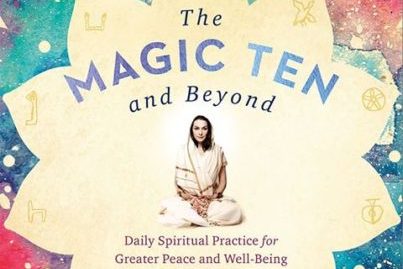Through repetition the magic is forced to rise. For a practice to yield sweet fruit it must be done regularly—daily is best. It should become a habit, a good habit like brushing your teeth. And like brushing your teeth, a daily yoga practice doesn’t have to take all day. Do it first thing in the morning and allow the benefits to unfold throughout the rest of the day. But if for some reason you are unable to do your practice first thing in the morning then do it later in the day or last thing before bed. The important thing is that you do it. Over time with consistent regular daily practice, along with a sense of detachment regarding specific results, the benefits will accumulate on their own accord. Abhyasa means to sit with something for a long time and vairaga means detachment. To practice, all the while being unconcerned with the results of the practice, is the way of the yogi who knows how to let go and let God. Transformation is always subtle and gradual, but non-the-less inevitable, if you’re willing to commit to consistency in your practice and sincerely surrender its fruits. Do your best and let God do the rest.

Yoga means to remember your connection to the Supreme Source, eternal happiness itself—the kind of happiness that is not dependent on any thing or condition. Yoga teaches that within each living being there is an eternal soul, the atman. Yoga practices enable us to reconnect to the atman and to understand that our mortal bodies are not who we really are—they are dwelling places for our immortal soul. Over time the practices alchemically transform our perception of who we are from the doer to the participant. The realized yogi lives in the world as an instrument for the light of truth. There are many yoga practices that can guide a person along the way to that magical remembering of who he or she really is—some of those practices are explored in this book in the form of mantras, prayers, blessings, affirmations, visualizations, asanas, dance steps, kriyas, pranayama, meditation, deep relaxation and feeding the birds.
The Sanskrit word sadhana means “conscious spiritual practice.” What distinguishes a yoga practice from a physical fitness exercise routine is the intention. When you engage in an activity with the conscious intention for it to bring you closer to enlightenment, then it is sadhana. Sadhana is never something you do for yourself. It is always about getting over yourself, your separate ego self, and awakening to how you are part of a higher Divine Self. But without the essential ingredient of bhakti, which means “devotion or love for God,” to help you relinquish doer-ship, your practices could keep you ego-centered and goal oriented, identified with your body and mind, tossed about by the ups and downs of life, bound in mundane reality and the pursuit of temporary happiness through material accumulation and forgetfulness of the real doer—the Supreme Self.
In this book I also share some of my ideas regarding the history of yoga and my speculations regarding a possible connection with ancient Egypt. Ten years ago this intuition led me to visit Egypt. While in the Great Pyramid lying in the King’s chamber I had an out of bodyexperience. A day later while at the Cairo Museum I saw a painting of a yogini in what appeared to be an asana and met an Egyptologist who would show me a magic circle, called a cartouche, containing ten hieroglyphs that looked to me like they could be describing yoga practices.
abhyāsa-vairāgyābhyāṁ tan nirodhah
“The cessation of all vrittis, of all thinking and modifications of the mindstuff, is brought about by persistent inner practice of Self-abidance, abiding in the ‘I-am’ beyond the body and mind, and by non attachment through discrimination.”
Teaching Tips
- You could choose to focus on one or more of the practices from the book and teach in depth. This is an abbreviated list of the ten practices that are outlined in the book:
- Gratitude
- Giving Blessings
- Feeding the Birds
- The Magic 10 asana sequence
- Dance
- Kriya: uddiyana bhandha and agni sara
- Kapalabhati and alternate nostril kapalabhati
- Samavritti pranayama
- Meditation
- Shavasana
- Read out loud from any section of the book or from the FOM essay and comment.
- Focus on one term from the Glossary in the back of the book and teach in depth
- Explore the theory that suggests yoga might have been practiced in the ancient Egyptian mystery schools.
- Teach the meaning of abhyasa (practice) and vairaga (detachment) and how Patanjali’s two-step program could lead to Yoga.
- Suggestions for inclusion on your playlist to accompany this FOM:
- No Goal but This by Miten from the CD: Temple At Midnight
- Surrender: by Gaura Vani from the CD: 10 Million Moons
- Surrender: by Donna de Lory from the CD: In the Glow
- Shri Krishna: by Kelly Britton from the CD: Refuge
Sharon Gannon is an animal rights and vegan activist and a world-renowned yogini, perhaps best known as the founder, along with David Life, of the Jivamukti Yoga Method. She is also an accomplished writer, dancer, painter, musician, and chef. She lives in a 125-acre wild forest sanctuary in Woodstock, NY.
Find all her books on Amazon here.



